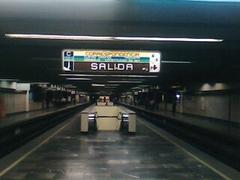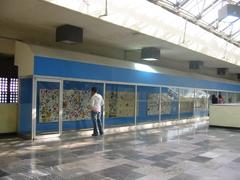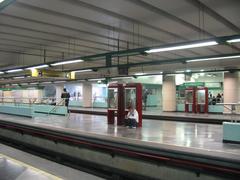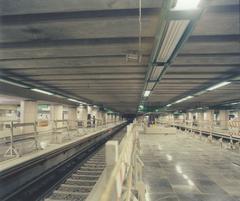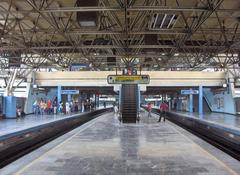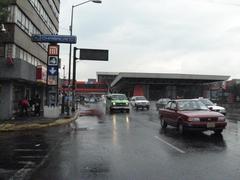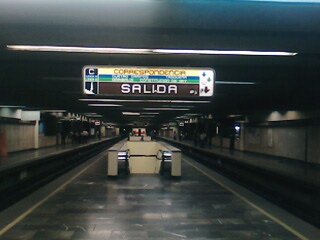
Chabacano Mexico City Visiting Hours Tickets and Historical Sites Guide
Date: 14/06/2025
Introduction to Chabacano Mexico City Historical and Cultural Significance
Nestled within the dynamic heart of Mexico City, Chabacano stands out as a compelling neighborhood that offers visitors a unique blend of rich history, vibrant culture, and seamless urban connectivity. Originally part of the ancient lakebeds of the Valley of Mexico, Chabacano has transformed over decades from reclaimed wetlands into a bustling urban enclave marked by its working-class heritage and lively street life. The area’s name, inspired by the apricot trees (“chabacano” in Spanish) that once flourished along its main avenue, reflects the neighborhood’s deep-rooted historical ties to Mexico City’s colonial and agricultural past (Wikipedia).
At the core of Chabacano’s modern identity lies the Chabacano Metro Station, a pivotal transit hub that connects three major metro lines (Lines 2, 8, and 9), facilitating easy access to the broader cityscape. Opened in the late 1960s and expanded over subsequent decades, this station is not only a functional infrastructural marvel featuring a distinctive multi-level design and the innovative “Spanish solution” platform layout, but also a cultural landmark adorned with murals and artwork celebrating local history (Wikiwand; MexicoHistorico).
Visitors to Chabacano can expect a safe and accessible environment, with the metro operating daily from approximately 5:00 AM to midnight and fares remaining affordable for travelers. Beyond transit, the neighborhood offers authentic Mexican experiences through its bustling markets, traditional eateries, and vibrant street art scene, making it a living gallery of Mexico City’s multicultural urban fabric. Its proximity to historic districts such as the Centro Histórico and landmarks like Torre Latinoamericana enhances its appeal as a convenient gateway for cultural exploration (lacgeo.com; timeout.com).
Whether you are a commuter, a history enthusiast, or a tourist seeking to immerse yourself in Mexico City’s authentic urban life, this comprehensive guide to visiting Chabacano provides essential information on its history, transportation options, safety tips, cultural highlights, and practical advice to ensure a rewarding experience in one of Mexico City’s most dynamic neighborhoods.
Table of Contents Covering Visiting Hours Tickets History and Travel Tips
- Welcome to Chabacano: A Vibrant Urban Neighborhood in Mexico City
- Historical Evolution of Chabacano: From Lakebed to Urban Neighborhood
- Chabacano Metro Station: Your Gateway to the Neighborhood
- Visiting Hours and Ticket Information
- Travel Tips for Visiting Chabacano
- Nearby Attractions and Recommended Activities
- Cultural Highlights
- FAQ: Your Questions About Visiting Chabacano
- Practical Information for Visitors
- Architectural Features and Design
- Platform Layout and Structure
- Accessibility and Modernization
- Functional Role in the Metro Network
- Major Transfer Hub
- Passenger Volume and Flow
- Commercial and Economic Activity
- Visitor Information: Tickets, Visiting Hours, and Tips
- Cultural and Social Significance
- Iconography and Identity
- Cultural Programming and Artistic Presence
- Film and Popular Culture
- Nearby Attractions
- Safety Considerations for Visitors
- General Safety Overview
- Safety Tips for Tourists
- Common Scams and How to Avoid Them
- Transportation in Chabacano and Mexico City
- Metro System
- Metrobus and Other Public Transit
- Taxis and Ride-Sharing
- Walking and Cycling
- Authentic Local Experiences in Chabacano
- Exploring the Neighborhood
- Nearby Historical Sites
- Language and Cultural Etiquette
- Accessibility
- Practical Tips for a Memorable Visit
- FAQ
- Conclusion and Call to Action
Welcome to Chabacano: A Vibrant Urban Neighborhood in Mexico City
Chabacano is a unique and vibrant neighborhood in Mexico City, rich in history and seamlessly connected by one of the city’s busiest Metro stations. Whether you’re a history enthusiast, a cultural explorer, or a traveler seeking an authentic urban experience, Chabacano offers a fascinating glimpse into Mexico City’s past and present. This guide will help you discover Chabacano’s historical roots, navigate its public transportation, and enjoy the neighborhood safely and conveniently.
Historical Evolution of Chabacano: From Lakebed to Urban Neighborhood
Originally part of the vast lakes and wetlands system that once defined the Valley of Mexico, Chabacano’s land was gradually reclaimed through draining and infilling. This transformation enabled the creation of new neighborhoods like Colonia Ampliación Asturias, Colonia Asturias, and Colonia Vista Alegre. The main road, Calzada de Chabacano, takes its name from the apricot (chabacano) trees that once thrived here (Wikipedia).
During Mexico City’s explosive growth from 1950 to 1980, Chabacano evolved from semi-rural lands into a densely populated urban area within the Cuauhtémoc borough. Its strategic location and infrastructure developments, especially the Metro, played a pivotal role in this transformation.
Chabacano Metro Station: Your Gateway to the Neighborhood
The Chabacano Metro station is a major interchange connecting Lines 2, 8, and 9, making it one of the most important transit hubs in Mexico City (Wikipedia). Opened in 1967, the Metro was designed to address urban transit needs during rapid city expansion (MexicoHistorico).
Visiting Hours and Ticket Information
- Metro Operating Hours: Approximately 5:00 AM to midnight daily.
- Tickets: Single-ride tickets cost a standard fare (check updated prices on the official Metro website).
The station’s unique architectural design and its role as a critical transfer point make it a notable site for visitors interested in urban infrastructure.
Travel Tips for Visiting Chabacano
- Safety: Chabacano is generally safe for tourists, especially around the Metro station and main avenues. Exercise usual urban precautions, particularly near busy intersections and after dark.
- Accessibility: The Metro station is equipped with escalators and elevators, facilitating access for people with disabilities.
- Transportation: Besides the Metro, local buses and taxis provide additional transit options.
Nearby Attractions and Recommended Activities
- Explore local markets and eateries around Calzada de Chabacano for authentic Mexican cuisine.
- Visit nearby historic districts, including the Mexico City historic center (Zócalo), just a short Metro ride away.
- Take a stroll to landmarks like Torre Latinoamericana for panoramic city views.
Cultural Highlights
The Chabacano Metro station is adorned with murals and artwork celebrating local history and culture, turning daily commutes into cultural experiences (MexicoHistorico). The neighborhood itself is alive with street life, markets, and community events that showcase the city’s vibrant urban culture.
FAQ: Your Questions About Visiting Chabacano
Q: What time does the Chabacano Metro station open and close? A: It operates roughly from 5:00 AM to midnight every day.
Q: Is Chabacano safe for tourists? A: Yes, the area is generally safe, but standard urban safety measures are recommended.
Q: What can I see near Chabacano? A: Nearby attractions include local markets, authentic eateries, the historic center (Zócalo), and landmarks like Torre Latinoamericana.
Q: Are there guided tours available in Chabacano? A: While specific guided tours of Chabacano are limited, many Mexico City tours include visits to nearby historic and cultural sites accessible via the Metro.
Practical Information for Visitors
- Getting There: Use the Mexico City Metro Lines 2, 8, or 9 to reach Chabacano station.
- Best Time to Visit: Weekdays during daylight hours for a less crowded experience.
- Local Amenities: Shops, markets, and eateries are abundant around the Metro station.
Summary
Chabacano offers visitors a compelling mix of history, culture, and urban life, anchored by one of Mexico City’s most important Metro stations. Whether you’re passing through or planning a deeper exploration, this neighborhood provides an authentic window into the megacity’s dynamic evolution.
Explore More About Mexico City
Call to Action
Ready to explore Chabacano and beyond? Download the Audiala app for real-time transit updates, maps, and insider tips. Follow us on social media for the latest travel guides and exclusive content about Mexico City’s hidden gems.
Visuals
Images of Chabacano Metro station with alt text: “Chabacano Metro Station Mexico City - Major interchange connecting Lines 2, 8, and 9”
Photos of Calzada de Chabacano street and local markets with alt text: “Calzada de Chabacano street view with apricot trees and local market”
Map illustrating Chabacano location in Mexico City with nearby attractions and Metro lines.
For further reading on Chabacano’s history and urban context, see Wikipedia, MexicoHistorico, National Geographic Blog, and New Geography.
Introduction
Chabacano Metro Station is a key transit hub in Mexico City, renowned for its unique architecture, cultural significance, and role as a major interchange connecting three metro lines. Whether you are a daily commuter, a tourist interested in historical sites, or someone exploring Mexico City’s vibrant urban fabric, this guide covers everything you need to know about visiting Chabacano Metro Station—including visiting hours, ticket information, architectural features, and cultural highlights.
Historical Background and Urban Context
Chabacano Metro Station, located in the Cuauhtémoc borough of central Mexico City, is a pivotal node in the city’s extensive metro network. Opened on August 1, 1970, as part of Line 2, the station has evolved into a major interchange, now serving Lines 2 (Blue), 8 (Green), and 9 (Brown) (Wikiwand). The station’s name, “Chabacano,” is derived from a nearby avenue once lined with apricot trees—“chabacano” meaning “apricot” in Mexican Spanish. This reflects the area’s colonial-era history, when reclaimed lakebed soil was used for fruit orchards, including apricots introduced from Asia (MexicoCity.cdmx.gob.mx). The neighborhoods served—Ampliación Asturias, Obrera, and Vista Alegre—are historically working-class, and the station’s development has mirrored the city’s urban expansion and modernization.
Architectural Features and Design
Platform Layout and Structure
Chabacano is unique among Mexico City’s metro stations for its complex, multi-level design and its use of the “Spanish solution” platform layout, a model developed in Barcelona. This configuration features an island platform flanked by two side platforms, allowing passengers to exit from one side of the train and board from the other, significantly improving passenger flow and reducing congestion (MexicoCity.cdmx.gob.mx). The station is both underground and at-grade, with each line occupying a different level or section:
- Line 2 runs along Calzada de Tlalpan.
- Line 8 is situated below Calle Juan A. Mateos.
- Line 9 is beneath Eje 3 Sur – Calzada Chabacano (Wikiwand).
The station’s tunnels are notable for their length: the Chabacano–Obrera tunnel on Line 8 is 1,143 meters, while the Chabacano–La Viga section is 843 meters. On Line 9, the tunnel to Lázaro Cárdenas is 1,000 meters, and to Jamaica, 1,031 meters (Wikiwand).
Accessibility and Modernization
Chabacano is equipped with accessibility features, including wheelchair ramps, two elevators, and escalators, all of which were renovated in 2021 to address obsolescence and improve usability for passengers with reduced mobility (Wikiwand). The station’s signage and wayfinding are part of the Mexico City Metro’s iconic visual language, designed by Lance Wyman and his team to be easily understood regardless of literacy level (GeekVibes). The station’s pictogram—a stylized apricot—serves as a visual anchor for navigation.
Functional Role in the Metro Network
Major Transfer Hub
Chabacano’s primary functional significance lies in its role as a triple-line transfer station, one of only a few in the entire system. It connects the north-south axis (Line 2), the northeast-southeast axis (Line 8), and the west-east axis (Line 9), making it a critical interchange for commuters traversing the city (Wikiwand). The station’s design allows for efficient transfers between lines without exiting the paid area, maximizing convenience and minimizing travel time.
Passenger Volume and Flow
As a major interchange, Chabacano experiences high passenger volumes, especially during peak hours (Monday to Friday, 6:00–10:00 a.m. and 5:30–9:00 p.m.). The station’s layout and multiple access points help manage these crowds, but visitors should be prepared for congestion during rush hours (MexicoDestinos). Off-peak travel is recommended for a more comfortable experience.
Commercial and Economic Activity
The station is not only a transit hub but also a vibrant commercial center. Both formal and informal vendors operate within and around the station, selling everything from snacks and drinks to natural remedies, clothing, and electronics (MexicoNewsDaily). Chabacano is particularly known for its “tiendas naturistas,” or natural product stores, reflecting the enduring popularity of traditional medicine in Mexico. The commercial activity extends to vintage clothing markets, especially on weekends, making the station a microcosm of Mexico City’s informal economy.
Visitor Information: Tickets, Visiting Hours, and Tips
Visiting Hours
Chabacano Metro Station operates daily from 5:00 a.m. to midnight, aligning with the Mexico City Metro system’s general schedule. These visiting hours allow ample time for commuters and visitors to explore the station and nearby attractions.
Tickets and Payment
- Ticket Prices: A single ride on the Mexico City Metro costs 5 pesos.
- Metro Card: The most convenient way to pay is with a Metro Card (“Tarjeta de Metro”), available for purchase and recharge at any station starting around 15 pesos (MexicoDestinos). Using a Metro Card streamlines entry and allows unlimited transfers within the system without additional cost.
Navigation and Travel Tips
- Route Planning: Study the metro map ahead of time or use the official Mexico City Metro app. Maps are also displayed throughout Chabacano Station (MexicoCity.cdmx.gob.mx).
- Transfers: Transfers between Lines 2, 8, and 9 are seamless within the paid area.
- Best Times to Visit: To avoid congestion, travel during off-peak hours outside of weekday mornings (6:00–10:00 a.m.) and evenings (5:30–9:00 p.m.).
- Safety: Keep personal belongings secure and stay alert in crowded areas to reduce the risk of pickpocketing (MexicoDestinos).
- Accessibility: Elevators, ramps, and escalators are available, making the station accessible for passengers with disabilities.
Special Events and Tours
Chabacano occasionally hosts cultural events such as classical music concerts and contemporary art installations in its spacious lobby (Wikiwand). Visitors interested in guided tours should check with local tourism offices or cultural centers for any scheduled events.
Cultural and Social Significance
Iconography and Identity
The Mexico City Metro’s iconography is a celebrated aspect of its design, and Chabacano’s apricot symbol is a nod to the area’s agricultural past (GeekVibes). The use of pictograms throughout the system fosters inclusivity and ease of navigation for all users, regardless of language or literacy. The station’s name and symbol thus serve as a bridge between the city’s history and its modern identity.
Cultural Programming and Artistic Presence
Due to its size and centrality, Chabacano hosts cultural events and performances in its lobby, ranging from classical music concerts to contemporary art installations (Wikiwand). The station’s spacious design makes it an ideal venue for such activities, contributing to the metro’s broader role as a space for public culture.
Film and Popular Culture
Chabacano has also made its mark in popular culture. Notably, scenes from the 1990 science fiction film “Total Recall,” starring Arnold Schwarzenegger, were filmed at the station. The production team transformed the station’s appearance to depict a futuristic setting, highlighting its modernist architecture and cinematic potential (Wikiwand).
Nearby Attractions
Chabacano’s central location makes it a convenient starting point for exploring nearby attractions such as Parque El Pípila and Casa de Cultura Alfonso Reyes (MexicoCity.cdmx.gob.mx). The surrounding neighborhoods offer a glimpse into the everyday life of Mexico City, with local markets, parks, and cultural centers within walking distance.
Frequently Asked Questions (FAQ)
Q: What are the visiting hours for Chabacano Metro Station? A: The station is open daily from 5:00 a.m. to midnight.
Q: How much does a ticket cost at Chabacano Metro Station? A: A single ride costs 5 pesos. You can also purchase a Metro Card for easier access.
Q: Is Chabacano Metro Station accessible for people with disabilities? A: Yes, the station has elevators, ramps, and escalators to assist passengers with reduced mobility.
Q: Can I transfer between Lines 2, 8, and 9 within the station? A: Yes, transfers are seamless and do not require exiting the paid area.
Q: Are there guided tours or cultural events at Chabacano? A: The station hosts occasional cultural events; check local listings for guided tours and special programming.
Conclusion
Chabacano Metro Station is more than just a transit point; it is a vibrant cultural landmark and an essential part of Mexico City’s urban life. With its unique architecture, accessibility features, rich history, and lively commercial and cultural activities, visiting Chabacano offers an authentic glimpse into the city’s character. For your next trip, plan your visit by checking ticket options and visiting hours, and consider exploring the nearby attractions to fully experience this dynamic area.
Stay updated on Mexico City Metro news and tips by downloading the Audiala app or following official social media channels to make the most of your visit.
Visiting Chabacano, Mexico City: History, Culture, and Practical Tips for Tourists
Introduction
Chabacano is a vibrant neighborhood and major metro hub located in the heart of Mexico City, blending rich historical significance with dynamic local culture. While not a traditional monument with entrance fees or guided tours, Chabacano offers visitors an authentic experience of Mexico City’s layered heritage, artistic expression, and community life. This article provides essential visitor information, cultural insights, and practical tips to help you explore Chabacano and its surroundings with ease.
Historical and Cultural Layers of Chabacano
Situated near Mexico City’s UNESCO World Heritage-listed Centro Histórico, Chabacano reflects the city’s evolution from the Aztec capital Tenochtitlan to a bustling modern metropolis. The neighborhood’s proximity to historic landmarks like the Palacio de Bellas Artes and Templo Mayor highlights its connection to Mexico’s colonial and indigenous past. Visitors can easily access these sites via Chabacano metro station, making it a convenient gateway to the city’s rich history (lacgeo.com).
Visiting Chabacano: Access and Practical Details
Chabacano Metro Station and Transportation: Chabacano is served by three metro lines (Lines 2, 8, and 9), making it one of Mexico City’s most accessible transport hubs. The station operates daily from 5 AM to midnight, with frequent train services. Tickets are affordable, costing approximately 5 MXN per ride, and metro cards can be purchased on-site.
Accessibility: The metro and surrounding streets are generally accessible to visitors with mobility needs, with elevators and ramps available at Chabacano station. Nearby cultural sites also provide visitor accommodations.
Guided Tours: While Chabacano itself does not offer formal guided tours, many walking tours of Mexico City include the neighborhood, highlighting its street art, markets, and local life. Visitors interested in deeper exploration can find tours focused on the historic center accessible via Chabacano station.
Diversity and Indigenous Heritage
Chabacano mirrors Mexico City’s multicultural makeup, hosting residents from numerous indigenous groups alongside long-established families and international visitors. Indigenous culture thrives here through vibrant markets, traditional festivals, and local initiatives promoting Nahuatl language preservation. Tourists can witness this heritage in daily life and community events that showcase traditional music, dance, and crafts (mexicohistorico.com).
Artistic Expression and Street Life
The neighborhood’s streets serve as an open-air gallery, with murals and graffiti that address social themes and celebrate Mexican identity. Visitors are encouraged to explore these colorful artworks, which often tell stories of community solidarity and history. Chabacano’s proximity to cultural institutions such as the Museo Nacional de Antropología and Palacio de Bellas Artes offers easy access to world-class exhibitions and performances (timeout.com).
Markets, Gastronomy, and Daily Life
Chabacano’s traditional markets are essential stops for visitors. Here, you can sample authentic Mexican cuisine like tacos al pastor and tamales or shop for artisanal crafts and fresh produce. These lively markets also offer a glimpse into the social fabric of the neighborhood, where locals gather and share stories.
Nearby neighborhoods such as Coyoacán and Roma provide complementary gastronomic experiences, from trendy cafes to international fare, making Chabacano a strategic starting point for culinary exploration (timeout.com).
Festivals, Rituals, and Public Celebrations
Chabacano actively participates in major citywide celebrations such as Día de los Muertos and Semana Santa, featuring colorful altars, processions, and communal meals. The nearby Zócalo hosts large events drawing residents from across Mexico City, including those from Chabacano, fostering cultural exchange and community spirit (eternalspringcdmx.com).
Urban Mobility and Connectivity
Thanks to its role as a transportation nexus, Chabacano serves as an ideal base for exploring Mexico City. The neighborhood’s walkability, access to metro lines, and proximity to green spaces like Bosque de Chapultepec provide visitors with numerous options for leisure and sightseeing (planetware.com).
Safety, Inclusivity, and Modern Challenges
Recent improvements in public safety and community policing have made Chabacano a welcoming destination for tourists. The neighborhood embraces diversity, with LGBTQ+ friendly spaces and multicultural events enriching the social landscape. Visitors should still exercise typical urban precautions, especially at night (pacificprime.lat).
Visuals and Media Recommendations
To enhance your visit, look for local maps illustrating Chabacano’s key attractions and public art locations. Many online platforms and visitor centers offer virtual tours and photo galleries showcasing the neighborhood’s murals and markets. When creating content or sharing your experience, use alt tags such as “Chabacano Mexico City murals” and “Chabacano market visitors” to increase visibility.
FAQ: Visiting Chabacano
Q: Does Chabacano have entrance fees or tickets? A: No, Chabacano is primarily a neighborhood and metro hub; there are no entrance fees. Access to nearby monuments like Palacio de Bellas Artes may require tickets.
Q: What are the visiting hours for Chabacano metro station? A: The metro operates daily from 5 AM to midnight.
Q: Are guided tours available in Chabacano? A: While there are no official tours of Chabacano itself, many city tours include visits to this neighborhood.
Q: Is Chabacano safe for tourists? A: The area is generally safe during the day; standard urban safety precautions are recommended, especially after dark.
Q: How can I experience local culture in Chabacano? A: Visit local markets, attend festivals, explore street art, and engage with community events.
Practical Tips for Visitors
- Explore by Metro: Use the Chabacano metro station for easy access to the neighborhood and surrounding attractions.
- Visit Markets: Spend time at local markets to experience authentic food and crafts.
- Respect Traditions: Participate respectfully in festivals and community events.
- Support Local Businesses: Choose family-run eateries and artisanal shops.
- Use Visual Guides: Take advantage of maps and virtual tours for a richer visit.
Conclusion and Call to Action
Chabacano’s unique blend of history, culture, and community life offers visitors an immersive and authentic Mexico City experience. Whether exploring its vibrant street art, savoring local flavors, or participating in festivals, Chabacano welcomes tourists seeking to connect with the city’s heart.
For more detailed guides, maps, and updates on cultural events in Chabacano and beyond, download the Audiala app. Follow us on social media and explore related articles to plan your visit and discover the many faces of Mexico City.
Introduction
Chabacano Metro Station is a vibrant transit hub and neighborhood in Mexico City, offering visitors a unique blend of efficient transportation, authentic local culture, and proximity to fascinating historical sites. This guide covers essential visitor information including Chabacano visiting hours, ticket options, safety tips, transportation details, and local experiences to help you make the most of your visit.
Visiting Hours and Tickets for Chabacano and Nearby Attractions
Chabacano Metro Station Hours and Tickets
Chabacano Metro Station operates daily with the following schedule:
- Monday to Friday: 5:00 AM to midnight
- Saturday: 6:00 AM to midnight
- Sunday: 7:00 AM to midnight
Tickets for the Metro cost 5 pesos per ride (approximately $0.30 USD). Visitors can purchase single-ride tickets at station booths or use the Integrated Mobility Card, which also works for Metrobus and other public transit options across Mexico City (Mexico City Government).
Visiting Hours and Tickets for Nearby Sites
- Mercado de San Antonio Abad: Open daily from 7:00 AM to 7:00 PM. No entry fee is required to explore this bustling market known for fresh produce and authentic street food.
- Museo Nacional de las Intervenciones: Located in Coyoacán, this museum is open Tuesday to Sunday from 10:00 AM to 5:00 PM. Admission is free on Sundays; otherwise, tickets cost approximately 50 pesos.
- Centro Histórico: Open year-round with museums and cultural sites typically operating between 9:00 AM and 6:00 PM. Ticket prices vary by attraction; many offer discounts for students and seniors.
Special guided tours around Chabacano and the surrounding neighborhoods can be booked through reputable agencies. These tours often include historical insights and local culinary experiences.
Safety Considerations for Visitors
General Safety Overview
Mexico City, including the Chabacano area, has significantly improved in safety over recent years. The city center and tourist zones, including Chabacano, are generally safe for visitors who follow standard precautions (Teo Mexico Tours; Travel Safe Abroad).
- Crime Rates: Violent crime against tourists is rare in the Chabacano area, though petty theft like pickpocketing can occur, particularly in crowded spaces such as the Metro (Travel Safe Abroad).
- Police Presence: Enhanced police patrols and surveillance have created a safer environment.
- Neighborhood Caution: Visitors are advised to avoid unfamiliar neighborhoods after dark and stay in well-lit, populated areas.
Safety Tips for Tourists
- Stay alert in crowded areas, especially around Metro stations and markets.
- Secure valuables and avoid displaying expensive items.
- Use authorized taxis or ride-sharing apps like Uber, Didi, or Cabify, particularly at night (Mexico City Government).
- Solo female travelers should stick to reputable accommodations, avoid dark side streets at night, and use ride-sharing apps (Teo Mexico Tours).
- Emergency services can be reached by dialing 911; Locatel (5658-1111) offers assistance in English and Spanish.
Common Scams and How to Avoid Them
- Avoid unauthorized taxis; use official stands or ride-sharing apps.
- Beware of pickpockets in crowded Metro cars and markets; use anti-theft bags and keep wallets in front pockets.
- Book tours only through reputable agencies or official tourism offices.
Transportation in Chabacano and Mexico City
Metro System
Chabacano Metro Station is a key interchange connecting Lines 2 (Blue), 8 (Green), and 9 (Brown), making it a vital transit point (Mexico City Government). The Metro is the fastest and most affordable way to navigate Mexico City.
- Operating Hours: 5:00 AM to midnight on weekdays, with later starts on weekends.
- Fares: Single rides cost 5 pesos; the Integrated Mobility Card can be used across multiple transit services.
- Safety: Women-only carriages are available during peak hours for added security (ExpatDen).
- Tips: Avoid rush hours (7–9 AM, 6–8 PM) to evade crowds and keep belongings secure.
Metrobus and Other Public Transit
- Metrobus operates dedicated lanes with stops near Chabacano; fares are 6 pesos per ride.
- Trolleybus and RTP buses provide access to areas not served by rail.
- Tren Ligero and Cablebús serve southern and hilly districts.
Taxis and Ride-Sharing
- Use authorized taxis at airports and official stands; prepay for airport taxis.
- Ride-sharing apps like Uber, Didi, and Cabify are reliable and safe.
- Car rentals are available but consider traffic and driving restrictions due to environmental regulations.
Walking and Cycling
- Central sidewalks are generally well-maintained but watch for uneven pavement.
- Mexico City’s bike-share program, Ecobici, offers a convenient cycling option, though riders should exercise caution in traffic.
Authentic Local Experiences in Chabacano
Exploring the Neighborhood
Chabacano offers an authentic glimpse into Mexico City’s working-class culture.
- Visit traditional markets like Mercado de San Antonio Abad (7:00 AM–7:00 PM) for fresh produce and street food.
- Sample local street foods such as tacos, tamales, and tortas from popular stalls.
- Enjoy family-run cafés and cantinas serving café de olla and local beers.
Nearby Historical Sites
- Parque de los Venados: A local favorite park accessible by Metro, ideal for relaxation.
- Museo Nacional de las Intervenciones: Explore Mexico’s military history in Coyoacán; open 10:00 AM–5:00 PM.
- Centro Histórico: Just a few stops north on Line 2, featuring museums, colonial architecture, and plazas.
Language and Cultural Etiquette
- Spanish is the primary language; basic Spanish phrases are appreciated.
- Greet vendors politely and tip 10–15% in restaurants.
- Dress modestly, especially in churches and traditional areas.
Accessibility
- Chabacano Metro Station is equipped with elevators and ramps.
- Public restrooms are available in Metro stations and major markets, often for a small fee.
Practical Tips for a Memorable Visit
- The city’s altitude results in mild temperatures year-round; bring a light jacket for evenings.
- Stay hydrated to mitigate mild altitude sickness symptoms.
- Drink bottled or filtered water; tap water is not potable.
- Free Wi-Fi is available in many public spaces including Metro stations and parks.
FAQ
Q: What are the Chabacano Metro station hours? A: Monday to Friday, 5:00 AM to midnight; Saturday, 6:00 AM to midnight; Sunday, 7:00 AM to midnight.
Q: How much do Chabacano Metro tickets cost? A: A single ride costs 5 pesos, and the Integrated Mobility Card can be used for multiple transit modes.
Q: Is it safe to visit Chabacano? A: Yes, with standard precautions such as avoiding unfamiliar areas at night and using authorized transport.
Q: Are there guided tours available in Chabacano? A: Yes, reputable agencies offer tours that include historical and culinary experiences.
Q: What are the visiting hours for Mercado de San Antonio Abad? A: The market is open daily from 7:00 AM to 7:00 PM.
Conclusion and Call to Action
Chabacano Metro Station and its surrounding neighborhood offer visitors a rich blend of cultural authenticity, easy transportation access, and proximity to Mexico City’s historical sites. By planning ahead with ticket and visiting hour information, staying safe, and engaging with local experiences, your visit can be both memorable and enjoyable.
For more tips, interactive maps, and virtual tours of Chabacano and Mexico City, explore our related articles and download the Audiala app to stay updated on the latest travel information. Follow us on social media for real-time updates and insider guides.
Visual Suggestions: Include high-quality images of Chabacano Metro station, Mercado de San Antonio Abad, and nearby historical sites with descriptive alt tags such as “Chabacano Metro Station entrance,” “Fresh produce at Mercado de San Antonio Abad,” and “Colonial architecture in Centro Histórico.” Interactive elements like transit maps and virtual neighborhood tours can enhance engagement.
Internal Links: Add links to related articles on Mexico City transit passes, popular historical sites, and safety tips on the hosting website to encourage deeper visitor engagement.
Conclusion and Call to Action for Visiting Chabacano and Staying Updated
Chabacano embodies the spirit of Mexico City’s evolution—from its origins as reclaimed lakebed to a vibrant urban neighborhood anchored by one of the city’s most important metro interchanges. Its unique combination of historical depth, architectural innovation, cultural richness, and practical accessibility makes it a must-visit destination for those wishing to experience the authentic pulse of the megacity. The Chabacano Metro Station itself is a testament to modern urban design and public art, facilitating efficient travel while offering passengers cultural insights through its murals and design elements (Wikiwand; MexicoHistorico).
Visitors can confidently navigate Chabacano thanks to its well-maintained infrastructure, accessibility features, and the safety improvements implemented in recent years. The neighborhood’s lively markets, traditional cuisine, street art, and community events provide an immersive cultural experience that complements visits to nearby historic sites and landmarks. By planning your visit around the metro’s operating hours and employing the travel tips provided, you can enjoy Chabacano’s offerings while avoiding peak congestion and common safety pitfalls.
This guide encourages travelers to delve beyond typical tourist paths and appreciate Chabacano’s authentic urban character. For updated transit information, cultural events, and insider tips, consider downloading the Audiala app and following official social media channels dedicated to Mexico City travel. Embrace Chabacano not just as a transit point, but as a vibrant, living neighborhood that showcases the diverse and evolving identity of Mexico City (MexicoDestinos; timeout.com).
References and Links to Official Websites and Related Articles
- Colonia Ampliación Asturias, Wikipedia, 2025 https://en.wikipedia.org/wiki/Colonia_Ampliaci%C3%B3n_Asturias
- Chabacano Metro Station, Wikiwand, 2025 https://www.wikiwand.com/en/Chabacano_metro_station
- The Story Behind Mexico City’s Iconic Metro System, MexicoHistorico, 2025 https://www.mexicohistorico.com/paginas/The-Story-Behind-Mexico-City---s-Iconic-Metro-System.html
- Historic Center Mexico City, lacgeo.com, 2025 https://lacgeo.com/historic-center-mexico-city
- Mexico City Metro Map, Stations, Lines, Schedules and Tips, MexicoDestinos, 2025 https://www.mexicodestinos.com/en/blog/mexico-city-metro-map-stations-lines-schedules-and-tips/
- Mexico City Travel Guide, timeout.com, 2025 https://www.timeout.com/mexico-city
